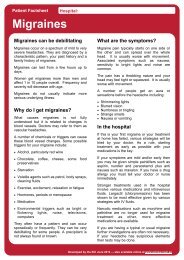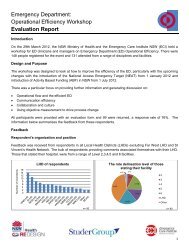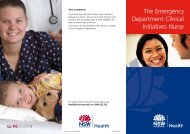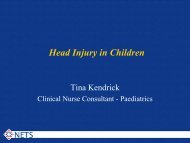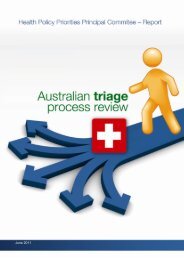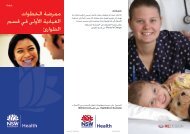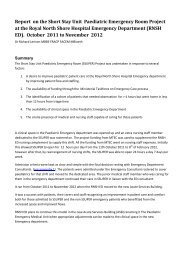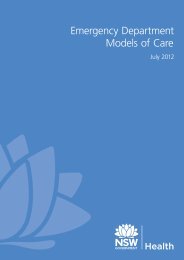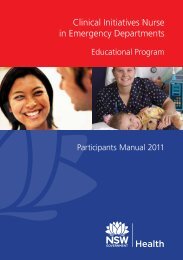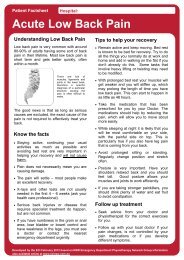Facilitators Manual - Emergency Care Institute
Facilitators Manual - Emergency Care Institute
Facilitators Manual - Emergency Care Institute
Create successful ePaper yourself
Turn your PDF publications into a flip-book with our unique Google optimized e-Paper software.
4.4 BREATHINGAimThe participant will on completion of this module be able to competently assess and manage apatient presenting to the emergency department with compromised breathing.Learning OutcomesBy completing this section, the participant will be able to:• Describe the normal principles of respiratory anatomy and physiology.• Take a comprehensive medical (respiratory) history.• Demonstrate basic skills in performing a respiratory assessment including inspection, auscultation,palpation and percussion.• Describe the common adventitious sounds that maybe heard on auscultation.• Interpret the clinical findings of an assessment of a patient with a breathing disorder including theirpurpose.• Identify normal arterial blood gas parameters.• Demonstrate the use of a peak flow meter and/or spirometer.• Have a greater understanding of chronic lung diseases and conditions that may have acuteexacerbations such as emphysema, asthma and chronic bronchitis.• Have a greater understanding of pathology in otherwise normal lungs resulting in acute shortnessof breath, pulmonary embolism, pneumonia, pneumothorax and atelectasis.• Describe the common oxygen delivery devices including the flow per minute and fraction of inspiredoxygen delivered.• Identify the indications for NIPPV.• Describe the nursing considerations when caring for a patient on NIPPV.• Demonstrate setting up of an underwater seal drainage system.• Describe the mode of actions, indications and potential side effects of the common medicationsused to treat patients with a respiratory disorder.35Content• Anatomy and physiology.• Conducting a comprehensive respiratory assessment/history- Inspection, palpation, auscultation, percussion- Taking a medical history- Interpretation of clinical assessment findings.• Common diagnostic tools used to assess a patient with a breathing disorder- Pulse oximetry- Spirometry- Peak flow- Chest X-Ray- Rationale for the use of diagnostic tools, interpretation of results and escalation/management- How to use a peak flow meter and/or spirometer.• Common oxygen delivery devices- Hudson mask, nasal cannulae, venturi mask, non-rebreather- Flow per minute and fraction of inspired oxygen delivered for common oxygen devices forcommon oxygen delivery devices.• Rationale, indications and special precautions of using NIPPV- What is NlPPV- Indications for NIPPV- Nursing considerations when caring for a patient with- NIPPV- UWSD.




